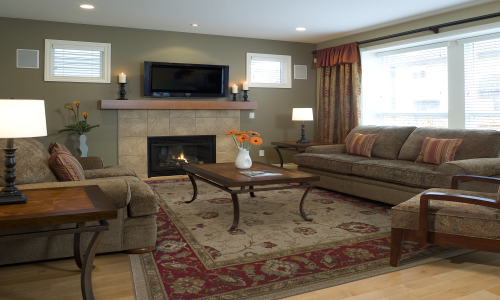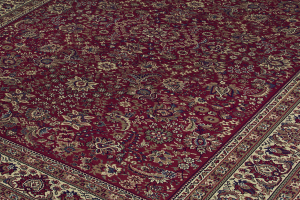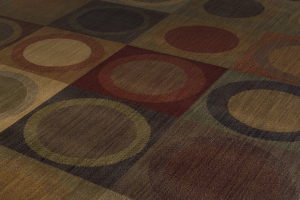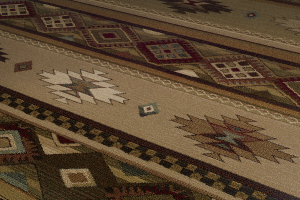
Rugs help create a mood for your room. For example, a
lighter shade of area rug can open up and brighten a space
while darker shades tend to create a more intimate mood.
Here are a few tips on choosing a rug design:
- Traditional versus contemporary rugs - choose a
style of rug that complements the colors and interior
design of your space. Think of your home's design, your
taste in furniture and other design elements to ensure
that a particular rug will blend in rather than detract
from the room's overall décor.
- Pattern on pattern - combining patterns in a room
can be done with the right attention. Curtains,
upholstery or pillows with small patterns should be
complemented with a rug featuring a larger pattern, and
vice versa. Florals, plaids, stripes and other patterns
can all work together providing they have size
distinction and coordinate in color.
- Texture adds depth - a rug with looped pile yarns or
a combination of cut pile and looped pile yarns atop a
smooth surface hardwood floor creates another layer to
the design and gives complexity to what would otherwise
be a flat palette of colors.
- Never try to match the main fabric color - it would
be next to impossible to match the exact red found in a
pillow. So find the second or third color in the pillow
or other design element and match families of colors
rather than specific colors.
- Traffic is key - rugs with condensed or repeating
patterns in darker colors show less dirt and grime over
time.
- Rugs look bigger on the rack - so you may have to
place a displayed rug on the floor to see it's natural
position. While time-consuming, this exercise is better
than having to return a rug later.
Rug designs are generally categorized in four different
styles:

TRADITIONAL - Traditional area rugs are typically modern-day
representations of more formal, time-honored European and
Asian designs reminiscent of either Oriental or Persian
motifs. Today's traditional designstypically incorporate
currentcolor pallets and sometimes an all-over geometric
pattern with linear components for a more simplistic design
as opposed to Oriental or Persian motifs. On the other hand,
traditional designs can include pictorials illustrating
elements from nature such as floral patterns.

CONTEMPORARY - Contemporary designs are characterized by
stark contrasts, bold use of color and sharp geometric
design elements. "Modern" designs tend to be more
architectural in feeling, such as art deco designs. They
tend to be assertive and bold, offering a strong statement
to a room¬s décor. On the other hand, "retro" designs
hearken back to styles that were first popular in the 60's
and early 70's. They take advantage of a free-form concept,
rarely having any rhyme or reason to the flow of the design.

CASUAL / TRADITIONAL - In a nutshell, transitional designs
are a blend of contemporary and traditional. Sometimes
referred to as "casual", they tend to be utilized to create
the elegance of a traditional design without the formality
they often project. Most transitional designs are
characterized through the use of open spaces containing a
sparse assortment of design components - sometimes
traditional and sometimes contemporary.

SOUTHWEST / TRIBAL - are characterized by those design
elements common to a specific culture or ethnic group. They
typically combine earth tones such as yellow, gold, red and
brownin very exacting and structured designs that offer
their own interpretation. Southwest or Tribals lend
themselves well to rooms that take on specific themes,
offering a unique way to tie the common elements of a
particular space together.
The construction of area rugs, though technical, is a key
element in researching the integrity of a product. Oriental
Weavers utilizes the Face-to-Face Wilton method to produce
the majority of our rugs because we've found it offers a
number of advantages, such as cost-efficiency and
exceptional quality.
One key advantage of the Wilton method is that this type of
construction lends itself well to a production process known
as "side-weaving". Weaving from side to side rather than top
to bottom enables up to 54 colors to be included into a
single rug design and delivers an end product with a softer,
denser pile. Plus, this process enables the rug's fringe to
be woven directly into the backing material for greater
durability.
Terms that are good to know:
Border - The design that forms the outside edge of a rug and
surrounds, or frames, the field.
Fringe - Extension of the wrap threads on two opposite ends
of the rug.
Hand - The tactile aesthetic qualities of carpet and
textiles; how it feels to the hand.

HAND-KNOTTED - Tying or knotting pile yarns around woven
backing fibers. The resulting face of the rugs is then
sheered to a pre-determined height to give the pile
uniformity. The more knots per square foot, the more
valuable the rug.

HAND-TUFTED - Using a tufting gun, pile yarns are forced
through a primary backing material known as a scrim. This
process forms a looped pile, and if left uncut the rug is
referred to as hand-hooked. If the loops are sheered off to
create a cut-pile look, it is referred to as hand-tufted.

HAND-CARVED - The cutting, or carving, of lines or design
patterns in a rug during the finishing process to create
texture and dimension giving the rug a greater apparent
value.

HEAT SET - this refers to a stage in the yarn production
process whereby two or more yarn fibers are twisted together
and then heated to ensure the yarns remain joined,
permitting greater design flexibility and appearance
retention.
KNOTS - the knot refers to the portion of the yarn that is
attached or knotted to the backing material. With regard to
cut-pile, machine-made area rugs, the knots are comprised of
two points. In other words, the face yarn is looped in a "U"
shape under the backing materials which, when finished, will
form two points and one knot. To determine the number of
knots in a rug, divide the number of points by two, and vice
versa.
PILE - the nap or amount of fiber that makes up the face of
the rug.
PILE HEIGHT - pile height is measured as the amount of yarn
visible from the top of the face yarn to the face of the
backing. Pile height is only measured on cut pile area rugs.
POINTS - a point, when referring to area rug construction,
is the tip end of a pile yarn and refers to the number of
yarns that make up an area rug. The more points per square
meter the denser the construction, and the more detailed the
rug. The typical quality area rug will have a minimum of
250,000 points per square meter.
PLY -One or more yarns are twisted together to form a larger
piece of yarn. Ply count indicates the number of single
pieces that have been twisted together, e.g. two-ply or
three-ply.
MEDALLION - The large, enclosed portion of a design, usually
in the center of the rug field. Common shapes are octagons,
hexagons, and diamonds.
There are three basic types of rug fiber - Polypropylene,
nylon and wool. All create beautifully-colored, rich designs
in a soft, thick, luxurious pile for unsurpassable style,
quality and value.

POLYPROPYLENE - is a petroleum-based fiber formed into yarns
by a process of extrusion, whereby pre-dyed polypropylene
pellets are melted down and extruded into a continuous
fiber. Strong and colorfast with a soft wool-like feel,
polypropylene resists wear and stains. It is value-driven
and the predominant machine-woven synthetic fiber with the
power to compete with the best wool rugs.
NYLON - like Polypropylene, nylon is extremely durable,
stain resistant and low in moisture absorbency. Nylon fibers
feature a soft luxurious texture and rich, lustrous
appearance.

WOOL - noted for luxury and softness, wool has a high build
of all natural fiber. In fact, it's natural ability to repel
water and resistance to breaking and compressing makes it a
very popular material for higher-end rugs.
A great advantage of polypropylene and nylon rugs is that
these non-porous fibers are essentially stainproof and
resistant to soiling from almost any chemical. Also, both
types produce little if any shedding and, being synthetic
they are less likely to affect those who struggle with
allergies










2.gif)















.png)